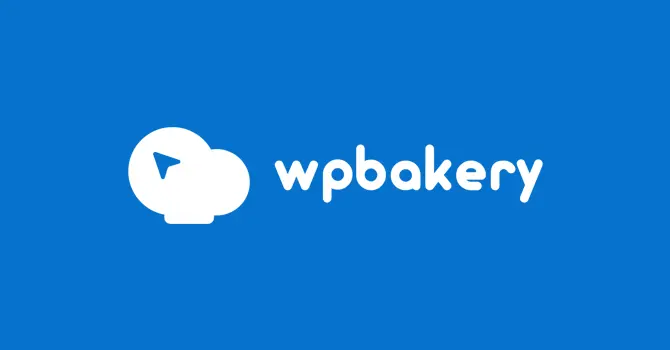
WPBakery is a well-established page builder WordPress known for its balance of flexibility and compatibility. It allows users to design websites through both frontend and backend editing, giving the freedom to choose between real-time visual layouts or structured admin panel control. The plugin is widely popular because it integrates seamlessly with thousands of WordPress themes, many of which come bundled with WPBakery by default.
In addition, it includes a broad collection of pre-built content elements such as sliders, buttons, and grids, making it possible to build professional pages quickly. Responsive design options ensure every layout adapts smoothly to desktops, tablets, and smartphones. Furthermore, the template library accelerates project delivery with ready-made designs, while its ecosystem of third-party add-ons provides endless opportunities for customization.
WPBakery is a long-standing page builder WordPress plugin that enables users to design websites without writing code. It provides both frontend and backend editing, giving flexibility for real-time visual design or structured admin control. Additionally, WPBakery comes bundled with thousands of premium WordPress themes, making it one of the most widely used builders in the ecosystem.
The plugin includes a variety of pre-built content elements, such as grids, buttons, and sliders, which help users create layouts quickly. It also integrates with most popular WordPress themes and plugins, ensuring broad compatibility. For advanced users, WPBakery supports custom CSS and JavaScript, making it adaptable to professional workflows as well.

Page Builder WordPress
WPBakery is one of the most established page builder plugins for WordPress, designed to help users create custom layouts without coding. Instead of working with shortcodes or HTML, it offers a drag-and-drop interface that makes web design more accessible. In addition, WPBakery comes bundled with many premium WordPress themes, which has contributed to its wide adoption.
Who is WPBakery for?
This page builder is ideal for users who want flexibility without learning complex coding languages. Freelancers and agencies often use it because of its compatibility with a wide range of themes and plugins. Business owners also rely on WPBakery to build professional websites without hiring developers. Moreover, beginners appreciate its straightforward approach, while advanced users value its extendability through custom code and add-ons.
Why Use WPBakery?
One of the main reasons to use WPBakery is its compatibility. Since it has been around for years, it works with a vast number of WordPress themes and plugins. Furthermore, it allows both frontend and backend editing, giving you the option to design in real time or work from the admin panel. Another strong advantage is the large selection of pre-built content elements, which help speed up the design process.
Key Features of Page Builder WordPress
Here are the most important features of WPBakery, ranked by significance:
- Drag-and-Drop Builder – Lets you design pages visually without coding, either in frontend or backend mode.
- Theme Compatibility – Works seamlessly with thousands of premium and free WordPress themes.
- Pre-Built Content Elements – Includes buttons, grids, sliders, icons, and more to quickly build layouts.
- Template Library – Offers a library of ready-to-use templates for faster project delivery.
- Responsive Design Controls – Ensures websites adapt to desktops, tablets, and smartphones.
- Add-on Compatibility – Supports numerous third-party add-ons for additional widgets and advanced functionality.
- Custom CSS and JavaScript Support – Provides flexibility for developers who want to add custom styling or scripts.
- Role Manager – Allows administrators to control what editing features are available to different user roles.
- Multilingual and RTL Support – Compatible with translation plugins, making it suitable for global websites.
Benefits of Page Builder WordPress
WPBakery offers a variety of advantages that make it a reliable option for WordPress users. Its long-standing presence in the market ensures stability and compatibility, which many website owners value.
Here are the most important benefits, ranked by significance:
- Theme Compatibility – Works seamlessly with thousands of free and premium WordPress themes.
- Frontend and Backend Editing – Provides flexibility to design either in real-time or through the admin panel.
- Pre-Built Content Elements – Speeds up design with ready-made buttons, grids, sliders, and more.
- Extensive Add-on Support – Expands functionality through a wide ecosystem of third-party extensions.
- Template Library – Offers professionally designed templates that save time on layout creation.
- Responsive Design Options – Ensures websites look great across desktops, tablets, and mobile devices.
- Custom Code Support – Enables advanced users to insert CSS or JavaScript for deeper customization.
- Multilingual Support – Works with popular translation plugins for international projects.
- Role Manager – Helps administrators assign editing permissions to different user roles.
Use Cases of WPBakery
Because of its flexibility, WPBakery can be applied to a wide range of website types. Its combination of drag-and-drop editing and strong compatibility makes it suitable for many industries.
Here are the most common use cases, arranged by importance:
- Business Websites – Perfect for companies that need professional, responsive layouts without hiring a developer.
- Agency and Freelancer Portfolios – Allows creative professionals to build visually appealing portfolios quickly.
- eCommerce Stores – Works well with WooCommerce to design custom product and shop pages.
- Blogs and Personal Sites – Helps bloggers customize layouts beyond default WordPress themes.
- Corporate Landing Pages – Useful for creating high-converting sales or marketing pages.
- Educational Websites – Compatible with LMS plugins for schools, online courses, and e-learning platforms.
- Nonprofit and Community Sites – Makes it simple for organizations to build engaging and functional websites.
Getting Started with WPBakery
Starting with WPBakery is straightforward, even for beginners. First, you need to install and activate the plugin, either by purchasing it directly or by using it if it comes bundled with your theme. Once activated, you can choose between frontend editing for real-time design or backend editing for a structured layout view.
Next, users can begin by adding pre-built content elements like text blocks, buttons, or image galleries. For quicker setup, the template library provides ready-to-use designs that can be customized to match your brand. Additionally, WPBakery includes responsive controls, ensuring your website looks perfect on desktops, tablets, and mobile devices.
As you grow comfortable, you can expand functionality by integrating third-party add-ons or applying custom CSS and JavaScript. This makes WPBakery not only beginner-friendly but also powerful enough for advanced designers and developers.
Extensions & Add-ons of WPBakery
One of WPBakery’s strongest points is its rich ecosystem of extensions and add-ons. These tools enhance the core builder and open up new design possibilities.
Here are the most important extension categories, ranked by significance:
- Element Libraries – Add hundreds of new design elements such as advanced sliders, pricing tables, charts, and countdown timers.
- WooCommerce Add-ons – Provide specialized modules for building custom product pages, checkout designs, and shop layouts.
- Design & Animation Packs – Introduce advanced animations, hover effects, and visual enhancements to make websites more engaging.
- Grid & Carousel Builders – Help create dynamic content grids, portfolio showcases, or testimonial carousels.
- Form Builders – Extend WPBakery with powerful forms for lead generation, surveys, and user interaction.
- Content Display Add-ons – Offer post grids, news tickers, and event listings for media-heavy websites.
- Integration Add-ons – Connect WPBakery with marketing tools, social media feeds, and CRM platforms.
- Custom Widgets – Allow developers to add unique elements tailored for specific business needs.
WPBakery vs Competitors
WPBakery has long been a trusted page builder in the WordPress ecosystem. However, its competitors—Elementor, Divi, and Beaver Builder—have grown rapidly, each offering modern alternatives. Understanding how WPBakery stacks up against them helps users choose the best tool for their needs.
WPBakery vs Elementor
- Editing Experience – Elementor uses a modern, live front-end editor, while WPBakery still relies heavily on backend editing with a less intuitive interface.
- Design Flexibility – Elementor provides advanced features such as theme builder, popup builder, and dynamic content, whereas WPBakery focuses on standard layouts.
- Performance – Elementor tends to be lighter and more optimized, while WPBakery sites may require extra tweaking for speed.
- Community & Ecosystem – Elementor has a massive global community and countless third-party add-ons, whereas WPBakery’s ecosystem is smaller but still active.
WPBakery vs Divi
- Ease of Use – WPBakery offers both frontend and backend editing, but Divi’s drag-and-drop builder is smoother for beginners.
- Design Resources – Divi includes thousands of pre-made layouts, while WPBakery relies more on its template library and third-party add-ons.
- Pricing – Divi provides lifetime pricing, which appeals to agencies, while WPBakery is a one-time purchase for single-site use.
- Performance – WPBakery may feel faster in backend editing, while Divi is more resource-intensive but visually powerful.
WPBakery vs Beaver Builder
- User Interface – Beaver Builder has a clean and minimal interface, whereas WPBakery feels more traditional.
- Features – WPBakery includes many built-in content elements, while Beaver Builder focuses on core essentials and relies on stability.
- Pricing – Beaver Builder allows unlimited site usage with its license, while WPBakery is limited per site unless bundled with a theme.
- Target Audience – WPBakery suits users who want flexibility and pre-built elements, while Beaver Builder appeals to developers who prioritize clean code and lightweight design.
Final Thoughts
WPBakery remains a reliable solution because of its compatibility with themes, built-in elements, and long market presence. Yet, Elementor leads with its modern editor and advanced features, Divi attracts users with its lifetime pricing and huge template library, and Beaver Builder appeals to developers seeking clean and stable performance.
For users who value tradition, stability, and theme integration, WPBakery is still a strong choice. However, for those looking for innovation, scalability, and advanced design control, competitors like Elementor or Divi may be better suited.
However, in today’s market, newer builders like Elementor and Divi offer more modern interfaces and advanced features. Even so, WPBakery remains highly relevant for those who prefer a traditional builder with proven reliability. In short, it is best suited for users who value theme flexibility, ease of use, and long-term stability over cutting-edge design innovations.



